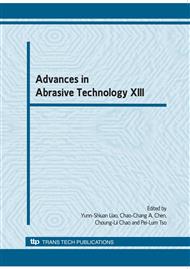[1]
Denkena, B.; de Leon, L.; van der Meer, M.: Diamond Tools for Complex Implant Surfaces. Advanced Material Research (76-78), pp.33-37 (2009).
DOI: 10.4028/www.scientific.net/amr.76-78.33
Google Scholar
[2]
Weule, H.; Timmermann, S.; Eversheim, W.: Automation of the Surface Finishing in the Manufacturing of Dies and Molds. CIRP Annals - Manufacturing Technology Vol. 39, pp.299-326, (1990).
DOI: 10.1016/s0007-8506(07)61058-0
Google Scholar
[3]
Denkena, B.; Boehnke, D.; Wang, B.: Manufacturing of functional microstructured surfaces by grinding with vitrified SiC- and cBN-wheels. International Journal of Abrasive Technology 2 (2), pp.207-222 (2009).
DOI: 10.1504/ijat.2009.022588
Google Scholar
[4]
Böß. V.: Werkzeugwege für das Bandschleifen von Freiformflächen. Dr. -Ing. thesis, Leibniz Universität Hannover (2007).
Google Scholar
[5]
Denkena, B.; Reichstein, M.; van der Meer, M.: Machining ceramic surfaces with adaptable diamond tools for complex implants. Industrial Diamond Review (2), pp.20-22 (2008).
Google Scholar
[6]
Weinert, K.; Blum, H.; Kuhlenkötter, B.; Schröder, A.; Zhang, X.; Scheele, C.; Surmann, T.: New methods for calculating the forces distribution within belt grinding process. Annals of the German Academic Society for Production Engineering (WGP), pp.285-289, (2007).
DOI: 10.1007/s11740-007-0054-4
Google Scholar
[7]
Zhong, Z.; Venkathesh, V.C.: Generation of Parabolic and Toroidal Surfaces on Silicon and Silicon-Based Compounds Using Diamond Cup Grinding Wheels. CIRP Annals - Manufacturing Technology Vol. 43, pp.323-326, (1994).
DOI: 10.1016/s0007-8506(07)62223-9
Google Scholar
[8]
Jansen, T.: Entwicklung einer Simulation für den NC-Formschleifprozess mit Torusschleifscheiben. Dr. -Ing. thesis, Technische Universität Dortmund (2007).
Google Scholar
[9]
Okuyama, S.; Kitajima, T.; Yui, A.: Theoretical Study on the Effect of Form Error of Grinding Wheel Surfaces under Free Form Grinding. Key Engineering Materials Vols. 257-258, pp.147-152, (2004).
DOI: 10.4028/www.scientific.net/kem.257-258.147
Google Scholar
[10]
Feng, X and B. Hongzan.: CNC Rake Grinding for a Taper Ball-End Mill with a Torus-Shaped Grinding Wheel. International Journal of Advanced Manufacturing Technology Vol. 21, pp.549-555, (2003).
DOI: 10.1007/s00170-002-1298-y
Google Scholar
[11]
Weinert, K.; Blum, H.; Jansen, Tim.: Simulation based optimization of the NC-shape grinding process with toroid grinding wheels. Annals of the German Academic Society for Production Engineering (WGP), pp.245-252, (2007).
DOI: 10.1007/s11740-007-0042-8
Google Scholar


